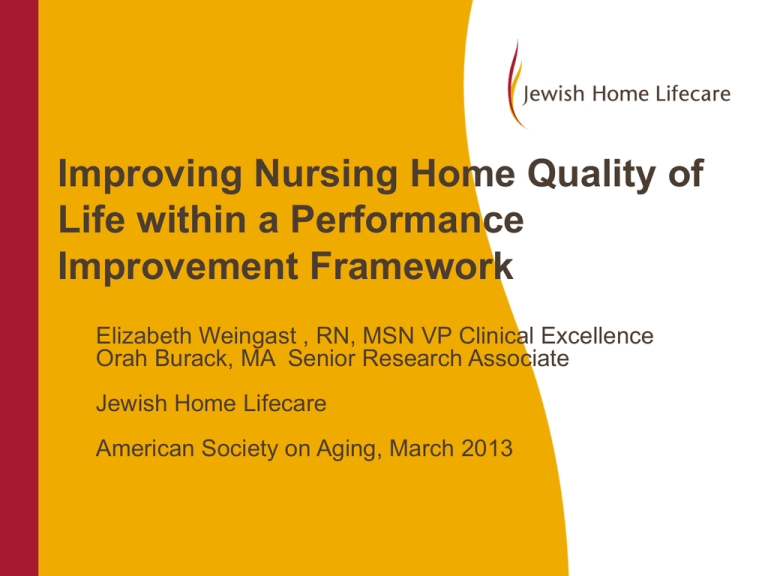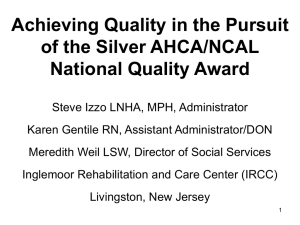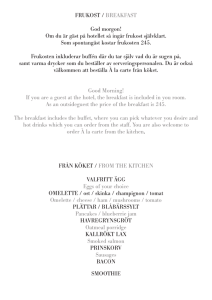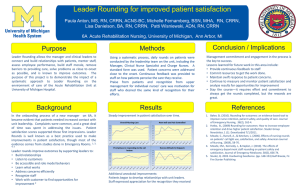Improving Nursing Home Quality of Life within a Performance
advertisement

Improving Nursing Home Quality of Life within a Performance Improvement Framework Elizabeth Weingast , RN, MSN VP Clinical Excellence Orah Burack, MA Senior Research Associate Jewish Home Lifecare American Society on Aging, March 2013 Overview • How to use a performance improvement model to improve nursing home quality of life within a person centered framework. 2 Jewish Home Lifecare (JHL) •JHL is over 160 years old. • Provides a true continuum of aging services. • Serves over 10,000 seniors annually. • Manhattan, Bronx, & Westchester, NY • Includes 3 large nursing homes with 46 long term care & subacute communities. • 1394 long term beds • 236 subacute beds Jewish Home Lifecare Values • Committed to Person Centered Care • Creating Green House® & Small Household model throughout long term care • Adopted a model of community based PI 4 Person Centered Care Decision making based on individual elder needs & preferences in all aspects of nursing home life including: • What food is available • When meals are served • What bathing choices are available • How work is structured in the organization 5 Industry Focus on Person Centered Care • Integral to long term care Green House® model • Increasingly viewed as essential to the delivery of quality care in the nursing home • Resident perspective included in MDS 3.0 & Quality Indicator Survey 6 What is PI concerned with in long term care? • Cornerstone of change management in nursing homes • Monitoring quality outcomes • Responding when outcomes are suboptimal •Traditionally used a department based model of performance improvement (PI) • Deliberate planning required to adjust PI model to fit decentralized model 7 Performance Improvement (PI) model changes with person centered care •Importance of person centered care in industry. •QAPI – Quality Assurance Performance Improvement regulations •If PI program models are not adjusted benefits and challenges of person centered care will not be adequately measured and potentially not adequately managed. 8 Project Overview Conduct a performance improvement initiative on one community at each of Jewish Home Lifecare’s 3 long-term care campuses that addresses the findings from the 2010 resident and family satisfaction surveys. Funded by United Hospital Fund 9 Project Goals • Obtain feedback from elders about their nursing home satisfaction (↑response rates). • Develop a community based replicable satisfaction improvement process to further person centered care in the nursing home •Empower the community to engage in selfdirected collaborative decision-making to improve community quality of life • Improve elder satisfaction at the community level 10 Steps to improve Survey Response Rate •Flyers on communities • Identified all interviewable elders • Trained survey interview team • English & Spanish surveys • Mailed postcard reminders • Followed up mailing with family phone calls • Second mailing 11 Satisfaction Survey Response Rate 2010-2011 30% 28% 24% 25% 25% 22% 20% Family 15% Resident 10% 5% 0% 2010 12 2011 Identifying Teams •Choosing study community •Leadership required •Who are the team members: ·Family Members ·Staff ·Residents ·Management 13 Educating Teams – PI process Community Meetings • Training staff, residents and family members together. • The Model for Improvement • Brainstorming changes toward a goal of improving quality of life and improvement in clinical care. 14 The Model For Improvement – Institute for Healthcare Improvement Part I: The Three Questions 1. Setting Aims - What are we trying to accomplish? •2. Establishing Measures - How will we know that a change is an improvement? •3. Selecting Changes - What changes can we make that will result in improvement? 15 Part II: Plan – Do – Study – Act Cycle PLAN Establish tasks required to set up the test of change ACT Review impact DO Implement change Of change by evaluating data and experience with change Consider spreading change As planned for specific Period of time STUDY Measure impact of change, gathering predetermined data 16 Barriers To Implementing Process •Facilitating weekly meetings with staff on study community. •Staffing issues that affected attendance •Staff member changes (SW, TR, Nursing) •Staff resistant to being identified as a community “leader” •Residents – core group •Families – difficult to recruit 17 Solutions to Barriers •Continued leadership participation led supported team participation. •Conducted one-to-one sessions regularly to accommodate staff with busy schedules. •Continuity bred enthusiasm and belief in project grew among staff and residents. •Catching new staff members up to speed (individual meetings). •Dedicated Project Coordinator 18 Identifying Survey Items for Change Community 1. The quality of the meals. The quality of the dining experience. Community 2. The quality of the meals. Elder /staff friendships. Community 3. Control of pain. Elder/staff friendships. 19 Translating Survey Items What do the residents really mean? 20 Community 1 Survey item - The quality of the meals. The quality of the dining experience. Identified problem: Limited variety Poor quality Unpleasant dining environment Overcrowding 21 Team Brainstorming •Breakfast Requests: Special Breakfast once a week Flavored coffee, Croissants, Danish, Muffins, Bagels, Creamed cheese, Butter •Lunch Requests: More variety at mealtime Lamb shank, oxtails, grilled sandwiches, Beef tongue, Rice and beans more regular, improve food & vegetable preparation, garlic, salt, pepper, lemon juice, oregano, Mrs. Dash, onion powder on table daily 22 Team Brainstorming •Evening & night time snacks easily available: cookies, cakes, bananas, yoghurt, fruit cups, smoothies •Enhance physical & social ambiance of dining room: new table clothes & centerpieces, plants, wall posters, flameless candles, condiments on table •Limited space: park wheelchairs at entrance of dining room, assist & encourage residents to “walk to dine 23 Priority areas selected for improvement Problem Too crowded Texture of food too soft or hard 24 Possible Who solutions Walk to dine. CNAs Smaller CNA Admin chairs Barriers Solutions Resident fear PT assess CNAs Worry On hold about falling Different food preferences Purposely made soft all can eat Not pursued Priority areas selected for improvement Problem Possible solutions Environment Centerpieces (flameless candles) Painting room Throw out old plants Buy new posters Remove old decor 25 Who Barriers Solutions Unit Candles will Resident Manager be taken store in Residentroom MH Environme ntal TR Admin TR Measures Tracked 1. Process Measures – fidelity of the study Are we doing what we say we are doing 2. Community Outcomes –change in result Did we make a difference on the community level 3. Resident Satisfaction Outcomes 26 Process Measures Tool created to track components of intervention & whether they are occurring. Too crowded Environment Breakfast Walk to dine Painting dining room Weekly special breakfast Fewer wheelchairs Throw out old plants and décor Flavored coffee Smaller chairs for CNAs Purchase new posters Muffins, bagels •Monitored on weekly basis. • Review findings with team to encourage successes & problem solve about barriers. 27 Process Findings: 7/2011-2/2012 Environmental Changes 20 18 16 14 12 10 8 6 4 2 0 None Some All Painted Redone Plants Posters Table Candles Walls Floors clothes 28 Process Findings: 7/2011-2/2012 Food choices All Some/by request 20 18 16 14 12 10 8 6 4 2 0 Spices 29 Flavored Creamer Bagel Muffins Butter Cream Cheese None Process Findings: 7/2011-2/2012 Walk to Dine 30 Community Outcomes • Survey items examine satisfaction with specific areas identified for change •Conduct every 4 to 6 months. •Review findings with team to encourage successes & problem solve about barriers. 31 Resident Satisfaction with Interventions Environmental Changes Have you noticed any recent changes in the dining room? (N=11) 10 Yes 1 No How satisfied/dissatisfied are you with the appearance of the dining room? (N=12) 7 Very Satisfied 2 Somewhat Satisfied 1 Very Dissatisfied 2 NA (Don’t eat in dining room) 32 Resident Satisfaction with Interventions Environmental Changes •There is a happier look to the dining room and very much appreciated. •The paintings brighten the room. •It looks like a museum they are very nice pictures. •Some pictures are very attractive and I just want to look at the bridge all the time. •I love the new look it is really beautiful. •It doesn’t matter much to me. 33 Resident Satisfaction with Interventions Breakfast Have you noticed any recent changes to the breakfast menu? (N=11) 8 Yes 3 No How satisfied/dissatisfied are you with breakfast? (N=12) 5 Very Satisfied 5 Somewhat Satisfied 2 Very Dissatisfied 34 Resident Satisfaction with Interventions Breakfast •It would be better if we got this [special breakfast] every day. •Unimproved. •It makes breakfast better for me. •It’s good for those who like it. •Scrambled eggs and the danish/croissant are very enjoyable with my coffee. 35 Resident Satisfaction Outcomes • Annual resident satisfaction survey •Review findings with team: assess current state, continue to improve same area, and/or focus on new area 36 Annual Satisfaction Survey: Quality of Meals 70% 60% 50% 55% 59% 58% 54% 47% 45% 42% 42% 40% poor/fair 30% good/excellent 20% 10% 0% G6 2010 37 G6 2011 Bronx 2010 Bronx 2011 Annual Satisfaction Survey: Quality of Dining Experience 90% 82% 80% 70% 60% 61% 52% 48% 50% 40% 60% 38% 41% 40% good/excellent 30% 20% 10% 0% G6 2010 38 poor/fair G6 2011 Bronx 2010 Bronx 2011 Annual Satisfaction Survey: Overall Satisfaction 90% 84% 80% 70% 74% 71% 73% 60% 50% poor/fair 40% 30% good/excellent 29% 20% 26% 27% 16% 10% 0% G6 2010 39 G6 2011 Bronx 2010 Bronx 2011 Outcomes •Consistent leadership and staff assignment is essential •PI model can be used to improve quality of live as well as clinical outcomes •Enthusiasm builds through persistence •Need to involve all key individuals in planning process 40 Priority areas selected for improvement Problem IDed Possible solutions Who Responsible Barriers Solutions 1.More variety 2. Too bland Special Menus Special breakfast flavored coffees, bagels, muffin tops Condiments available Meet with Kitchen Staff 1.TR staff 2.Kitchen too integrate in regular breakfast 3.Back to TR Kitchen & FSW Some foods i.e. lamb shanks oxtails too expensive 1. Many flavored coffees difficult to manage 2.TR staff changed 3. Kitchen said would have to do this on all units. Therefore only 1X/23 weeks. No safe place for condiments Consider alternatives 1.Flavored creamers 2.New TR staff agreed to take on roll. 3.Kitchen will handle as regular breakfast 1X/week. 4. TR again as weekly activity b/c kitchen “can’t be done if not facilitywide. Need locked space 41








